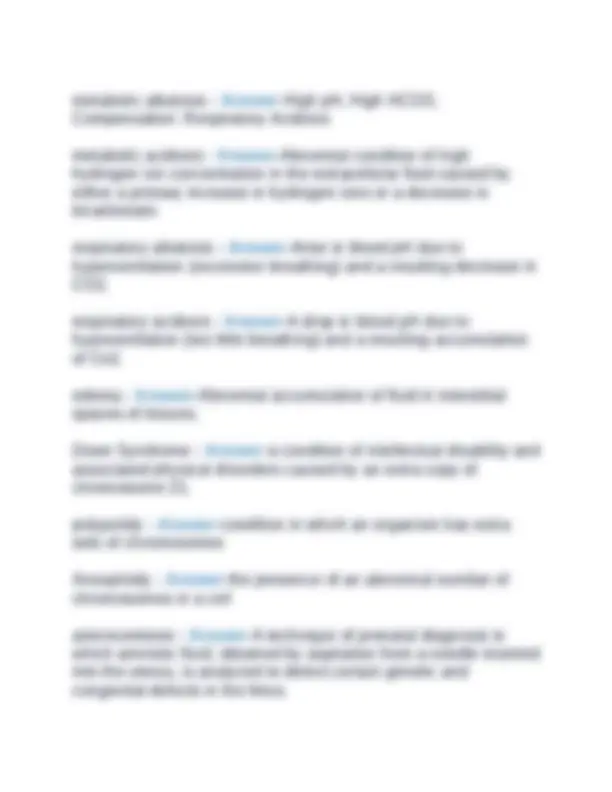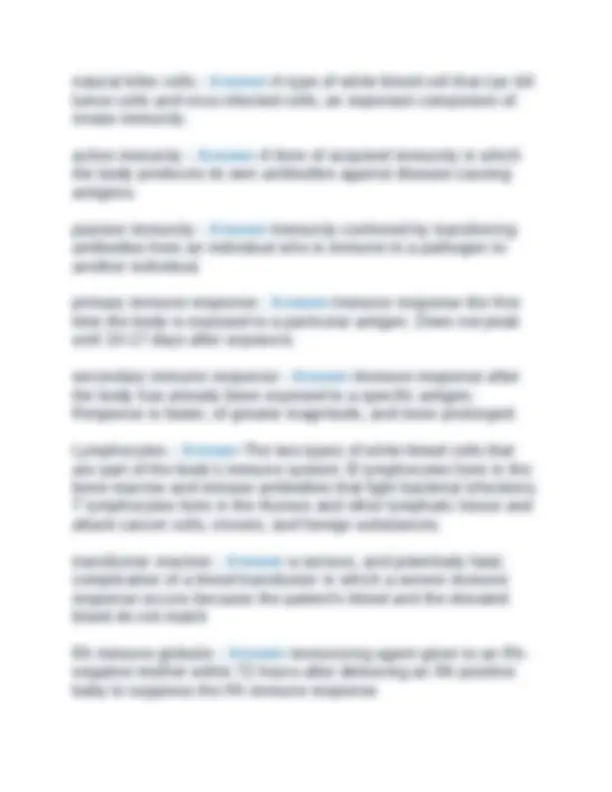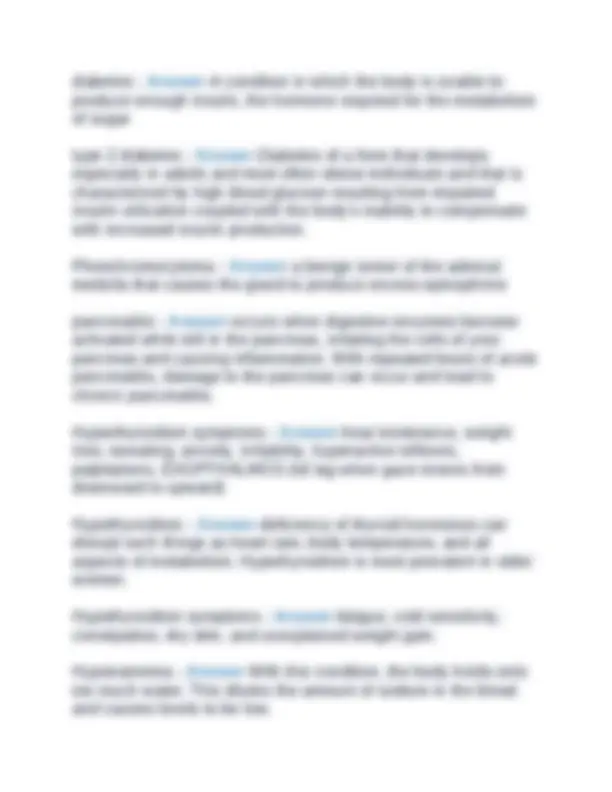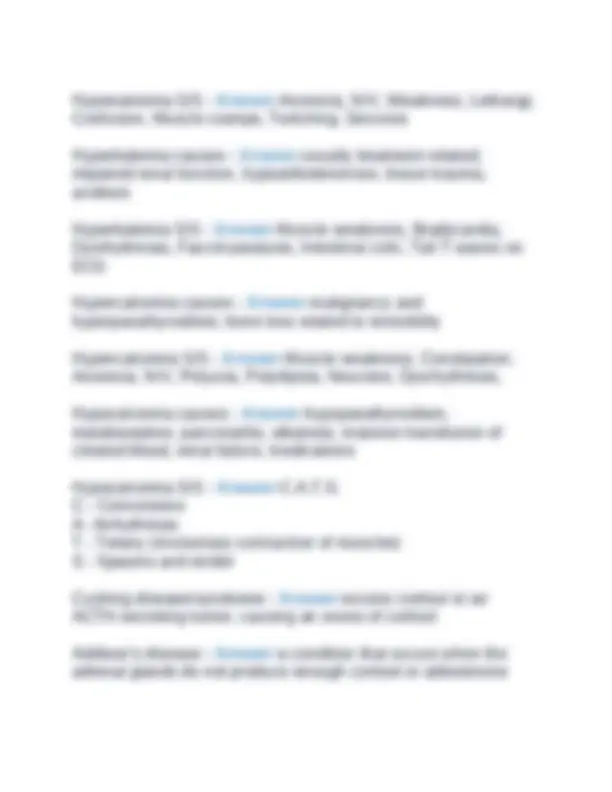














Study with the several resources on Docsity

Earn points by helping other students or get them with a premium plan


Prepare for your exams
Study with the several resources on Docsity

Earn points to download
Earn points by helping other students or get them with a premium plan
Community
Ask the community for help and clear up your study doubts
Discover the best universities in your country according to Docsity users
Free resources
Download our free guides on studying techniques, anxiety management strategies, and thesis advice from Docsity tutors
NURS 6501 MIDTERM WEEKS 1-6 TOPICS Question and Answers| Latest Update 2025 NURS 6501 MIDTERM WEEKS 1-6 TOPICS Question and Answers| Latest Update 2025
Typology: Exams
1 / 20

This page cannot be seen from the preview
Don't miss anything!













Phagocytosis - Answer -process in which extensions of cytoplasm surround and engulf large particles and take them into the cell lysosomal enzymes - Answer -can hydrolyze proteins, fats, polysaccharides, and nucleic acids oxidative phosphorylation - Answer -When energy is released at each step of the chain is stored in a form the mitochondrion can use to make ATP. Glycolisis - Answer -the breakdown of glucose by enzymes, releasing energy and pyruvic acid. passive transport - Answer -The movement of materials through a cell membrane without using energy active transport - Answer -the movement of materials through a cell membrane using energy Cellular Adaptation - Answer -the cell's response to escape and protect itself from injury cellular injury - Answer -occurs if cell is unable to maintain homeostasis free radicals - Answer -Unstable molecules that cause biochemical aging, especially wrinkling and sagging of the skin.
oxidative stress - Answer -a condition in which the production of oxidants and free radicals exceeds the body's ability to handle them and prevent damage chemical injury - Answer -Toxic chemicals or poisons can cause cellular injury both indirectly and by becoming metabolized into reactive chemicals by the body carbon monoxide - Answer -a colorless, odorless toxic flammable gas formed by incomplete combustion of carbon. lead poisoning - Answer -A medical condition caused by toxic levels of the metal lead in the blood necrosis - Answer -tissue death Apoptosis - Answer -programmed cell death Hyponatremia - Answer -low sodium blood levels due to consuming too much water without electrolytes Hypernatremia - Answer -increased temp, weakness, disorientation, dilusions, hypotension, tachycardia. give hypotonic solution. Hypokalemia - Answer -deficient level of potassium in the blood Hyperkalemia - Answer -high levels of potassium in the blood Hypocalcemia - Answer -CATS Convulsions, Arrythmias, Tetany, spasms and stridor Hypercalcemia - Answer -muscle weakness, lack of coordination, abdominal pain, confusion, absent tendon reflexes, shallow respirations, emergency!
Fragile X Syndrome - Answer -A genetic disorder involving an abnormality in the X chromosome, which becomes constricted and often breaks. Klinefelter syndrome - Answer -A chromosomal disorder in which males have an extra X chromosome, making them XXY instead of XY. Turner Syndrome - Answer -A chromosomal disorder in females in which either an X chromosome is missing, making the person XO instead of XX, or part of one X chromosome is deleted. Neurofibromatosis - Answer -genetic disorder with multiple benign fibrous tumors that grow anywhere in the nervous system including the brain, spinal cord, and peripheral nerves Familial Hypercholesterolemia - Answer -A metabolic disorder that is caused by defective or absent receptors for LDLs on cell surfaces, that is marked by an increase in blood plasma LDLs and by an accumulation of LDLs in the body resulting in an increased risk of heart attack and coronary heart disease, and that is inherited as an autosomal dominant trait. type 1 diabetes mellitus - Answer -diabetes caused by a total lack of insulin production; usually develops in childhood, and patients require insulin replacement therapy to control the disorder nitric oxide - Answer -a gas released by the endothelial cells to promote blood flow mast cells - Answer -Cells that release chemicals (such as histamine) that promote inflammation. fever - Answer -elevated body temperature
natural killer cells - Answer -A type of white blood cell that can kill tumor cells and virus-infected cells; an important component of innate immunity. active immunity - Answer -A form of acquired immunity in which the body produces its own antibodies against disease-causing antigens. passive immunity - Answer -Immunity conferred by transferring antibodies from an individual who is immune to a pathogen to another individual. primary immune response - Answer -Immune response the first time the body is exposed to a particular antigen. Does not peak until 10-17 days after exposure. secondary immune response - Answer -Immune response after the body has already been exposed to a specific antigen. Response is faster, of greater magnitude, and more prolonged. Lymphocytes - Answer -The two types of white blood cells that are part of the body's immune system: B lymphocytes form in the bone marrow and release antibodies that fight bacterial infections; T lymphocytes form in the thymus and other lymphatic tissue and attack cancer cells, viruses, and foreign substances. transfusion reaction - Answer -a serious, and potentially fatal, complication of a blood transfusion in which a severe immune response occurs because the patient's blood and the donated blood do not match Rh immune globulin - Answer -immunizing agent given to an Rh- negative mother within 72 hours after delivering an Rh-positive baby to suppress the Rh immune response
circulatory system - Answer -(aka cardiovascular system) This system works as the transportation highway for the body. It consists of the heart, blood, and blood vessels. It transports substances such as oxygen, carbon dioxide, and nutrients in the body. heart wall - Answer -3 layers: epicardium, myocardium, endocardium Chambers of the heart - Answer -right atrium, right ventricle, left atrium, left ventricle papillary muscles - Answer -responsible for pulling the atrioventricular valves closed by means of the chordae tendineae Bainbridge reflex - Answer -(also, called atrial reflex) autonomic reflex that responds to stretch receptors in the atria that send impulses to the cardioaccelerator area to increase HR when venous flow into the atria increases cardiac output - Answer -The volume of blood ejected from the left side of the heart in one minute. cardiac preload - Answer -Force of venous return; the stretch of cardiac muscle prior to contraction determined by ventricular filling pressure cardiac afterload - Answer -The force that the heart has to pump against; arterial pressure; inversely related to stroke volume atrial kick - Answer -slight pause of impulse between SA and AV so the blood has time to push into the ventricles
turbulent flow - Answer -Irregular flow with random variations in pressure. SA node - Answer -pacemaker of the heart parasympathetic nervous system - Answer -the division of the autonomic nervous system that calms the body, conserving its energy tunica media - Answer -The middle and thickest layer of tissue of a blood vessel wall, composed of elastic tissue and smooth muscle cells that allow the vessel to expand or contract in response to changes in blood pressure and tissue demand. Laplace's Law - Answer -Force acting on blood vessel wall is proportional to diameter of the vessel times blood pressure Frank-Starling Law - Answer -The greater the stretch, the stronger is the heart's contraction. This increased contractility results in an increased volume of blood ejected (Increased SV) cardiomyocytes - Answer -cardiac muscle cells Atherosclerosis - Answer -condition in which fatty deposits called plaque build up on the inner walls of the arteries myocardial infarction - Answer -the occlusion of one or more coronary arteries caused by plaque buildup (heart attack) claudication - Answer -pain, tension, and weakness in a leg after walking has begun, but absence of pain at rest pericarditis - Answer -inflammation of the membrane surrounding the heart
tidal volume - Answer -Amount of air that moves in and out of the lungs during a normal breath pulmonary embolism - Answer -A blood clot that breaks off from a large vein and travels to the blood vessels of the lung, causing obstruction of blood flow. Asthma - Answer -A chronic allergic disorder characterized by episodes of severe breathing difficulty, coughing, and wheezing. pulmonary edema - Answer -fluid in the air sacs and bronchioles pleural effusion - Answer -abnormal accumulation of fluid in the pleural space pulmonary fibrosis - Answer -formation of scar tissue in the connective tissue of the lungs empyema - Answer -accumulation of pus in the pleural cavity Emphysema - Answer -a condition in which the air sacs of the lungs are damaged and enlarged, causing breathlessness. cough - Answer -sudden, noisy expulsion of air from the lungs Hyperventilation - Answer -the condition of taking abnormally fast, deep breaths atelectasis - Answer -collapsed lung; incomplete expansion of alveoli aspiration - Answer -Breathing fluid, food, vomitus, or an object into the lungs
COPD (chronic obstructive pulmonary disease) - Answer -disease with enlarged lung spaces, usually from smoking can cause shortness of breath Bronchiolitis - Answer -Inflammation of the bronchioles that usually occurs in children younger than 2 years and is often caused by the respiratory syncytial virus. Kussmaul respirations - Answer -very deep, labored breathing (usually associated with diabetic acidosis and renal failure) glomerular filtration rate - Answer -amount of filtrate formed in all the renal corpuscles of both kidneys each minute renal medulla - Answer -inner portion of the kidney renal cortex - Answer -outer portion of the kidney Vitamin D function - Answer --promotes bone mineralization (makes calcium and phosphorus available to blood that bathes bones) -assists in immune function urethral sphincter - Answer -A muscular organ that controls the release of urine from the body antidiuretic hormone - Answer -hormone secreted by the posterior pituitary gland to prevent the kidneys from expelling too much water Natriuretic peptides - Answer -secreted by atrial myocardium of the heart in response to high blood pressure
Renin - Answer -hormone secreted by the kidney; it raises blood pressure by influencing vasoconstriction (narrowing of blood vessels) Acute Kidney Injury - Answer -rapid-onset disease of the kidneys resulting in a failure to produce urine ESRD (end stage renal disease) - Answer -the last stage of chronic kidney disease requiring transplantation or dialysis kidney stones - Answer -Solid crystalline masses formed in the kidney, resulting from an excess of insoluble salts or uric acid crystallizing in the urine; may become trapped anywhere along the urinary tract. renal colic - Answer -an acute pain in the kidney area that is caused by blockage during the passing of a kidney stone chronic kidney disease - Answer -the progressive loss of renal function over months or years dialysis - Answer -a procedure to remove waste products from the blood of patients whose kidneys no longer function cystitis - Answer -inflammation of the bladder glomerulonephritis - Answer -inflammation of the glomeruli of the kidney incontinence - Answer -inability to control bladder and/or bowels stress incontinence - Answer -the inability to control the voiding of urine under physical stress such as running, sneezing, laughing, or coughing
nephrotic syndrome - Answer -group of clinical signs and symptoms caused by excessive protein loss in urine renal cancer - Answer -about 2% of cancers; more common in males; most are malignant tumors that can spread via the lymphatics gastric motility - Answer -The activity of muscles of the stomach wall that mixes and propels stomach contents. Microvilli - Answer -Fingerlike extensions of plasma membrane of apical epithelial cells, increase surface area, aid in absorbtion, exist on every moist epithelia, but most dense in small intestine and kidney Kupffer cells - Answer -macrophages in the liver pancreatic acinar cells - Answer -exocrine cells of the pancreas hepatocytes - Answer -liver cells; produce bile, absorb and secrete nutrients like glucose, and secrete plasma proteins parietal cells - Answer -secrete HCl and intrinsic factor bile acids - Answer -cholesterol-containing acids found in the bile that act like detergents to break up fats in the small intestine Salivation - Answer -the elaboration of the mixed secretion (saliva) produced primarily in three bilateral pairs of glands in the mouth known as salivary glands pancreatic enzymes - Answer -digestive proteins found in pancreatic secretions that breakdown all organic nutrients
GERD (gastroesophageal reflux disease) - Answer -A digestive disease in which stomach acid or bile irritates the food pipe lining. Dumping syndrome - Answer -Rapid emptying of gastric contents into small intestines. Client experience ab pain, nausea, vomiting, explosive diarrhea, weakness, dizziness, palpitations & tachycardia. Glucocorticoids - Answer -raises blood sugar levels antidiuretic hormone (ADH) - Answer -Hormone produced by the neurosecretory cells in the hypothalamus that stimulates water reabsorption from kidney tubule cells into the blood and vasoconstriction of arterioles. Aldosterone - Answer -Hormone that stimulates the kidney to retain sodium ions and water Cortisol - Answer -stress hormone released by the adrenal cortex adrenocorticotropic hormone - Answer -stimulates the growth and secretions of the adrenal cortex negative feedback - Answer -A primary mechanism of homeostasis, whereby a change in a physiological variable that is being monitored triggers a response that counteracts the initial fluctuation. diabestes insipidus - Answer -a rare disorder caused by hyposecretion of arginine vasopressin (or antidiuretic hormone) by the pituitary gland; kidneys unable to conserve water thyrotoxic crisis - Answer -toxic condition characterized by hyperthermia, tachycardia, nervous symptoms, and rapid metabolism; also known as thyroid storm.
Diabetic Ketoacidosis (DKA) - Answer -A form of hyperglycemia in uncontrolled diabetes in which certain acids accumulate when insulin is not available. Hypothyroidism - Answer -condition of hyposecretion of the thyroid gland causing low thyroid levels in the blood that result in sluggishness, slow pulse, and often obesity Hyperthyroidism - Answer -overactivity of the thyroid gland Graves disease - Answer -an autoimmune disorder that is caused by hyperthyroidism and is characterized by goiter and/or exophthalmos hyperparathyroidism - Answer -hypersecretion of the parathyroid glands, usually caused by a tumor jaundice - Answer -yellowing of the skin and the whites of the eyes caused by an accumulation of bile pigment (bilirubin) in the blood Bilirubin - Answer -orange-yellow pigment in bile; formed by the breakdown of hemoglobin when red blood cells are destroyed urinary tract infection - Answer -infection of one or more organs of the urinary tract pyelonephritis - Answer -inflammation of the renal pelvis and the kidney Diverticulitis - Answer -inflammation of the diverticula
Hyponatremia S/S - Answer -Anorexia, N/V, Weakness, Lethargy, Confusion, Muscle cramps, Twitching, Seizures Hyperkalemia causes - Answer -usually treatment related, impaired renal function, hypoaldosteronism, tissue trauma, acidosis Hyperkalemia S/S - Answer -Muscle weakness, Bradycardia, Dysrhythmias, Faccid paralysis, Intestinal colic, Tall T waves on ECG Hypercalcemia causes - Answer -malignancy and hyperparathyroidism, bone loss related to immobility Hypercalcemia S/S - Answer -Muscle weakness, Constipation, Anorexia, N/V, Polyuria, Polydipsia, Neurosis, Dysrhythmias, Hypocalcemia causes - Answer -hypoparathyroidism, malabsorption, pancreatitis, alkalosis, massive transfusion of citrated blood, renal failure, medications Hypocalcemia S/S - Answer -C.A.T.S. C - Convulsions A- Arrhythmias T - Tetany (involuntary contraction of muscles) S - Spasms and stridor Cushing disease/syndrome - Answer -excess cortisol or an ACTH-secreting tumor, causing an exess of cortisol Addison's disease - Answer -a condition that occurs when the adrenal glands do not produce enough cortisol or aldosterone
Addison's disease symptoms - Answer -chronic fatigue, muscle weakness, anorexia, nausea, vomiting, diarrhea, hypotension, hypoglycemia, sweating, irritability, weight loss